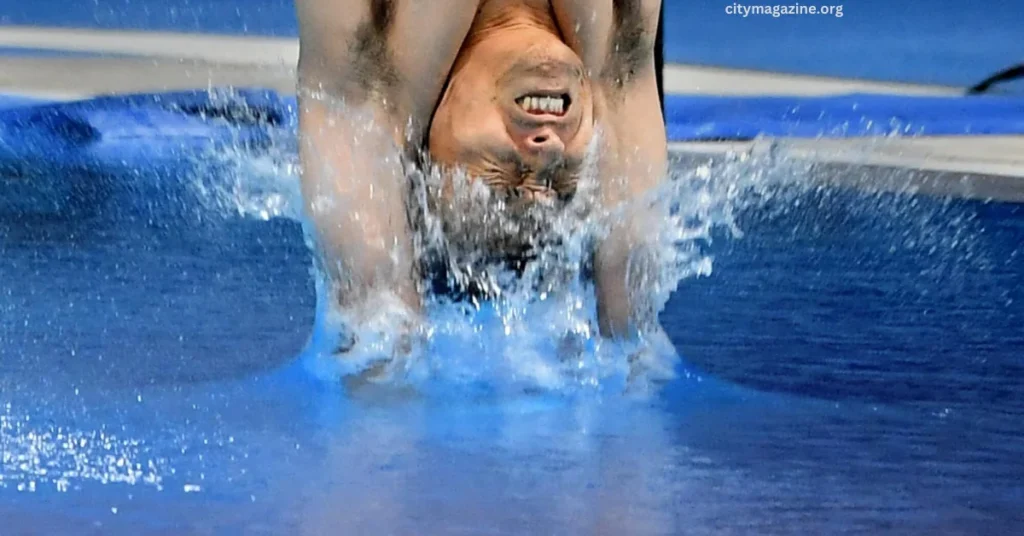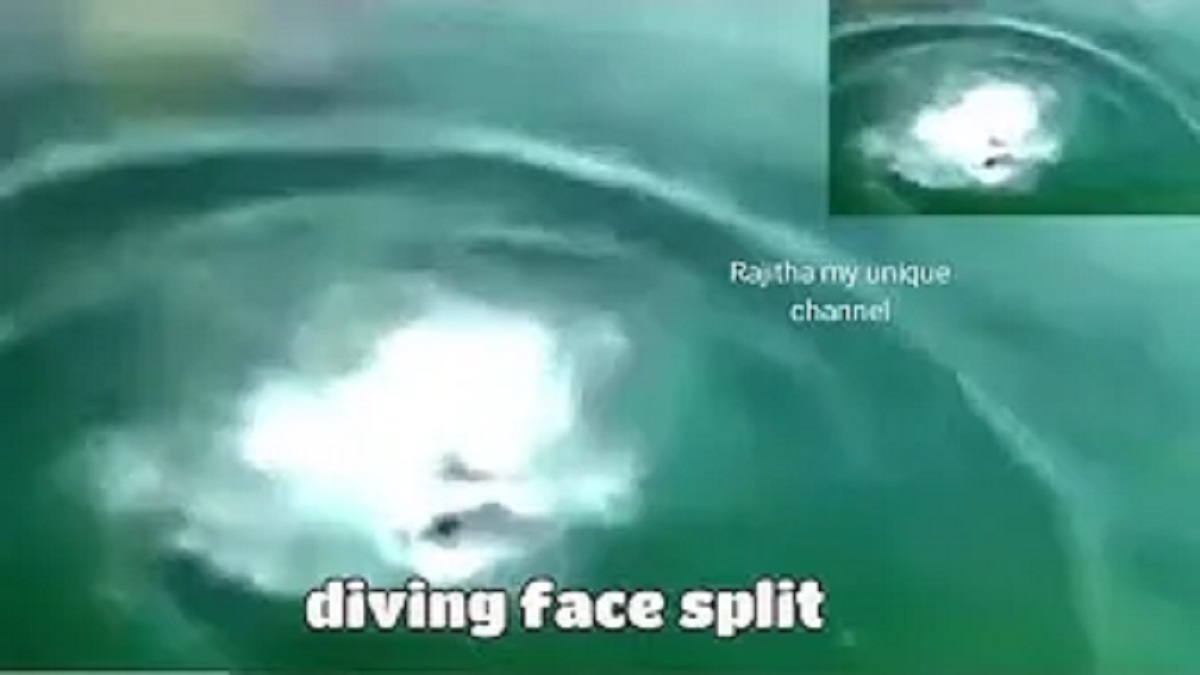Split Face Dive: The Ultimate Adventure For Thrill Seekers
Split face dive has become a sensation among adventure enthusiasts around the globe. Imagine diving into crystal-clear waters and experiencing the breathtaking beauty of marine life while simultaneously enjoying the stunning views of the surrounding landscape. It's no wonder why this activity has captured the hearts of so many travelers and nature lovers alike. Whether you're an experienced diver or a complete beginner, split face dive offers something truly unique and unforgettable.
This thrilling activity allows you to explore both the underwater world and the majestic scenery above the surface all at once. Picture yourself suspended between two worlds, with half of your body submerged in the vibrant blue ocean and the other half basking in the warmth of the sun. It's like living in a dream, and trust me, once you try it, you'll be hooked. Split face dive is not just an activity; it's an experience that will leave you craving more.
So, what exactly makes split face dive so special? Well, it combines the excitement of diving with the serenity of nature, creating a perfect balance that caters to all types of adventurers. From adrenaline junkies to those seeking peaceful escapes, this activity has something for everyone. In this article, we'll dive deep into the world of split face dive, uncovering everything you need to know to make the most out of your experience. So buckle up and get ready for an adventure like no other!
Table of Contents
- What is Split Face Dive?
- History of Split Face Dive
- Benefits of Split Face Dive
- Best Locations for Split Face Dive
- How to Prepare for Split Face Dive
- Equipment Needed for Split Face Dive
- Safety Tips for Split Face Dive
- Common Mistakes to Avoid
- Split Face Dive vs Traditional Diving
- Final Thoughts
What is Split Face Dive?
Split face dive, also known as snorkel diving, is a unique way to explore the underwater world while keeping one part of your body above water. This technique allows divers to enjoy the best of both worlds – the stunning marine life beneath the surface and the breathtaking views above. It's like having a front-row seat to nature's grand performance. Whether you're a seasoned diver or a newcomer, split face dive offers an accessible and exciting way to connect with the ocean.
Imagine floating effortlessly on the water's surface, your mask dividing your view between the vibrant coral reefs below and the picturesque landscapes above. It's like being in two places at once, and trust me, it's an experience you won't forget in a hurry. Plus, it's a great way to ease into the world of diving if you're a bit nervous about going all in. Split face dive truly is the perfect gateway for anyone looking to dip their toes into the world of underwater adventures.
Why Split Face Dive?
One of the coolest things about split face dive is that it's super accessible. Unlike traditional scuba diving, which requires certification and a bunch of gear, split face dive is much simpler and more user-friendly. All you need is a mask, snorkel, and fins, and you're good to go. Plus, it's a great way to build confidence in the water without feeling overwhelmed. So whether you're a pro or a noob, this activity has something for everyone.
History of Split Face Dive
The origins of split face dive can be traced back to ancient times when humans first started exploring the ocean. Back in the day, people used rudimentary tools like hollow reeds to breathe underwater while hunting for food. Over time, these techniques evolved into what we now know as snorkeling and split face diving. It's pretty wild to think that something we do for fun today was once a matter of survival.
In the mid-20th century, advancements in technology brought about the development of modern snorkeling gear, making it easier than ever for people to explore the underwater world. The introduction of the split face mask in the 1990s revolutionized the sport, allowing divers to enjoy both the surface and the depths simultaneously. Today, split face dive has become a popular activity worldwide, attracting thrill-seekers and nature lovers alike.
Key Milestones in Split Face Dive History
- Prehistoric times: Early humans use primitive tools to breathe underwater.
- 1950s: Modern snorkeling gear is developed, making the sport more accessible.
- 1990s: The split face mask is introduced, changing the game for divers everywhere.
Benefits of Split Face Dive
Split face dive offers a ton of benefits that make it an attractive option for adventure enthusiasts. First and foremost, it's a great way to stay active while enjoying the beauty of nature. The physical activity involved in swimming and diving helps improve cardiovascular health and builds muscle strength. Plus, being surrounded by the calming presence of water has been shown to reduce stress and promote mental well-being.
Another awesome benefit of split face dive is the opportunity to connect with marine life. Imagine swimming alongside colorful fish, sea turtles, and even sharks (don't worry, they're usually pretty chill). It's like stepping into a real-life aquarium, except you're the one doing the exploring. And let's not forget the stunning views – from coral reefs to sunken ships, there's no shortage of awe-inspiring sights to discover.
Top 5 Benefits of Split Face Dive
- Improved physical fitness
- Stress relief and mental well-being
- Close encounters with marine life
- Access to breathtaking underwater landscapes
- Accessible and beginner-friendly
Best Locations for Split Face Dive
When it comes to split face dive, location matters. Some of the best spots in the world offer crystal-clear waters, vibrant marine life, and stunning landscapes that make the experience truly unforgettable. From the Great Barrier Reef in Australia to the Maldives in the Indian Ocean, there's no shortage of amazing places to explore. Each destination has its own unique charm and attractions, so it's worth doing some research to find the perfect spot for your adventure.
Top 5 Locations for Split Face Dive
- The Great Barrier Reef, Australia: Home to thousands of species of marine life and coral reefs.
- Maldives: Known for its crystal-clear waters and luxurious resorts.
- Palau, Micronesia: Famous for its jellyfish lakes and vibrant coral reefs.
- Bora Bora, French Polynesia: Offers breathtaking views and pristine beaches.
- Red Sea, Egypt: Known for its diverse marine life and colorful coral reefs.
How to Prepare for Split Face Dive
Before you jump into the water, it's important to prepare properly for your split face dive adventure. First and foremost, make sure you're in good physical shape. Swimming and diving can be physically demanding, so it's a good idea to get some exercise beforehand to build up your stamina. Additionally, familiarize yourself with the basics of snorkeling and diving to ensure a safe and enjoyable experience.
Another crucial step is to check the weather and water conditions at your chosen location. You don't want to get caught in rough seas or strong currents, so it's always best to plan ahead. And don't forget to pack the right gear – a comfortable mask, snorkel, and fins are essential for a successful dive. With a little preparation, you'll be ready to take on the adventure of a lifetime.
Preparation Checklist
- Get in shape with regular exercise
- Learn the basics of snorkeling and diving
- Check weather and water conditions
- Pack the right gear: mask, snorkel, fins
Equipment Needed for Split Face Dive
Having the right equipment is key to a successful split face dive experience. A good quality mask is essential for clear visibility and comfort, so make sure it fits properly and doesn't leak. A snorkel is also important for breathing while you're floating on the surface, so choose one that's easy to use and comfortable. And don't forget the fins – they'll help you move through the water more efficiently and reduce fatigue.
Other useful items include a wetsuit or rash guard to protect your skin from the sun and a buoyancy control device to help you maintain your position in the water. If you're planning to take photos or videos of your adventure, consider investing in a waterproof camera or GoPro. With the right gear, you'll be all set for an amazing split face dive experience.
Essential Gear List
- Mask
- Snorkel
- Fins
- Wetsuit or rash guard
- Buoyancy control device
- Waterproof camera (optional)
Safety Tips for Split Face Dive
Safety should always be a top priority when engaging in any water-based activity. To ensure a safe and enjoyable split face dive experience, follow these simple tips. First, always dive with a buddy – never go it alone. Having someone with you can make all the difference if something goes wrong. Second, be aware of your surroundings and watch out for potential hazards like strong currents or sharp coral.
Third, make sure you're comfortable with your gear before heading into the water. Practice using your mask and snorkel in a controlled environment, like a pool, before venturing into open water. And finally, listen to your body – if you feel tired or uncomfortable, take a break and rest. By following these safety tips, you'll be able to enjoy your split face dive adventure with peace of mind.
Top Safety Tips
- Dive with a buddy
- Be aware of your surroundings
- Practice using your gear beforehand
- Listen to your body and take breaks when needed
Common Mistakes to Avoid
Even the most experienced divers can make mistakes, but by being aware of the common pitfalls, you can avoid them and have a more enjoyable experience. One of the biggest mistakes is overexerting yourself – remember, split face dive is supposed to be fun, not a competition. Another common error is not checking your gear properly before diving, which can lead to leaks or other issues that ruin your experience.
Additionally, some divers forget to acclimate themselves to the water temperature, which can cause discomfort or even cramps. Lastly, don't forget to apply sunscreen – you don't want to end up with a nasty sunburn after your adventure. By avoiding these common mistakes, you'll be able to fully enjoy your split face dive experience.
Avoid These Mistakes
- Overexerting yourself
- Not checking your gear properly
- Not acclimating to water temperature
- Forgetting to apply sunscreen
Split Face Dive vs Traditional Diving
While split face dive and traditional diving both offer incredible underwater experiences, they cater to different types of adventurers. Traditional diving requires more gear, training, and certification, making it a more involved activity. On the other hand, split face dive is much more accessible and beginner-friendly, allowing anyone to jump in and explore the underwater world without much fuss.
That being said, traditional diving offers a deeper and more immersive experience, as it allows divers to explore greater depths and stay underwater for longer periods. It's perfect for those who want to fully immerse themselves in the marine environment. Ultimately, the choice between split face dive and traditional diving comes down to personal preference and experience level. Both activities have their own unique appeal and offer unforgettable experiences.
Final Thoughts
Split face dive is an incredible way to connect with nature and experience the beauty of the underwater world. From its rich history to its numerous benefits, this activity has something to offer everyone. Whether you're a seasoned diver

What is The split face dive

Why you should avoid the head split dive accident trend

Face Split Diving Accident Incident Spain Everything's we know about